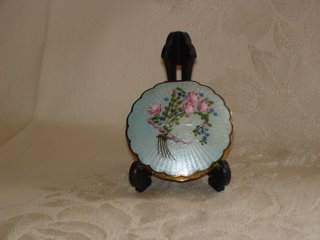
A lovely cloisonne compact in cavewoman's collection. The colors and detailing make this one stand out against all the others in her collection.
The process of cloisonne from wikipedi: First, the artist forms metal (such as copper or brass) into the shape of the finished object.
A paper pattern and a pencil are used to transfer a design to the metal object.
Partitions (French: cloisons) that act as color-separators are applied according to the transferred pattern and are held in place by a soldering paste (this is finely divided metal of low melting temperature in a flux paste). The partitions are bent and cut to length from flat wire stock (usually by hand using simple pliers) while the paste is applied with a small brush. Heating the piece in an oven permanently affixes the partitions the base metal by, melting the solder. The piece then cools.
Frit (glass crushed to a powder) in a water-based paste is painted into the partitions using an annotated pattern similar to the "paint by numbers" craft technique. After the frit has dried, firing in an oven melts it onto the metal. Several repetitions of the process may ensue to build up the coatings to the height of the partitions. Various colors and transparencies may be used in combination within a single partition to obtain the desired artistic effect.
The glass and a portion of the cloisons are ground and polished to form an even and smooth surface.
The exposed metal is electroplated with a thin film of gold to prevent corrosion and to give a pleasing appearance.
photo by cavewoman



5 Inspired Comments:
That the most beautiful one I have seen to date.
I agree with the above. Just gorgeous. I want it!! :)
It is beautiful and very intricate. A perfect compact!
It isn't cloisonne. It's guilloche.
Cloisonne objects are made by filling, with enamel, a number of separate cells defined by wires fused to the surface of a piece of metal. The wires which define the cells are not covered by the enamel. They just surround the enamel.
Guilloche objects are those to which a transparent or translucent enamel has been applied over a machine-stamped surface. The stamping is often a minute, repeating pattern reminiscent of the interlocking or twisting scroll motifs carved in stone as architectural ornaments, which are also called guilloche.
Sometimes, however, the guilloche for enamelwork is stamped in a repeating geometric pattern, or in a radiating pattern, outward from the center of the piece of jewelry or other object.
Guilloche stamping may provide a subtle background to a design created in the enamel, or it can itself be the principal ornamental focus of a piece.
The guilloche stampwork is seen through the enamel as if through the depths of water; it is completely covered by the enamel.
--- Art teacher, Ohio
Thanks art teacher from Ohio! You are better than wikipedia!
Post a Comment
<< Home